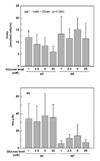Effects of low glucose concentrations on oxygen consumption rates of intervertebral disc cells
- PMID: 17762806
- PMCID: PMC2679584
- DOI: 10.1097/BRS.0b013e318145a521
Effects of low glucose concentrations on oxygen consumption rates of intervertebral disc cells
Abstract
Study design: Investigation of the effects of low glucose concentrations on the oxygen consumption rates of intervertebral disc cells.
Objectives: To determine the oxygen consumption rate of porcine anulus fibrosus (AF) cells at different glucose concentrations and to examine the differences in the oxygen consumption rate between AF and nucleus pulposus (NP) cells at different glucose levels.
Summary of background data: Poor nutrient supply has been suggested as a potential mechanism for degeneration of the intervertebral disc (IVD). Distribution of nutrients in the IVD is strongly dependent on transport properties of the tissue and cellular metabolic rates. Previous studies have shown dependence of oxygen consumption rate of IVD cells on oxygen tension, pH levels, and glucose levels outside the physiologic range. However, the oxygen consumption rate of AF cells at in vivo glucose levels has not been investigated.
Methods: IVD cells were isolated from the outer AF and NP of 4- to 5-month-old porcine lumbar discs. The changes in oxygen tension were recorded when cells were cultured in sealed metabolism chamber. The oxygen consumption rate of cells was determined by theoretical curve fitting using the Michaelis-Menten equation.
Results: The outer AF cells cultured in high glucose medium (25 mmol/L) exhibited the lowest oxygen consumption rate, whereas no significant differences in oxygen consumption rates were found among outer AF cells cultured at physiologic glucose levels (i.e., 1 mmol/L, 2.5 mmol/L, 5 mmol/L). The oxygen consumption rate of NP cells was significantly greater than that of outer AF cells.
Conclusion: Since the oxygen consumption rates determined in this study are comparable to the findings in the literature, this study has developed a new alternative method for determining oxygen consumption rate. The oxygen consumption rates of IVD cells reported in this study will be valuable for theoretically predicting local oxygen concentrations in IVD, which can provide a better understanding of transport of oxygen in the discs.
Figures








Similar articles
-
Comparison of Oxygen Consumption Rates of Nondegenerate and Degenerate Human Intervertebral Disc Cells.Spine (Phila Pa 1976). 2018 Jan 15;43(2):E60-E67. doi: 10.1097/BRS.0000000000002252. Spine (Phila Pa 1976). 2018. PMID: 28542098 Free PMC article.
-
Metabolism of the intervertebral disc: effects of low levels of oxygen, glucose, and pH on rates of energy metabolism of bovine nucleus pulposus cells.Spine (Phila Pa 1976). 2005 Mar 1;30(5):487-96. doi: 10.1097/01.brs.0000154619.38122.47. Spine (Phila Pa 1976). 2005. PMID: 15738779
-
Effects of Glucose Deprivation on ATP and Proteoglycan Production of Intervertebral Disc Cells under Hypoxia.Sci Rep. 2020 Jun 1;10(1):8899. doi: 10.1038/s41598-020-65691-w. Sci Rep. 2020. PMID: 32483367 Free PMC article.
-
Nutrient supply and intervertebral disc metabolism.J Bone Joint Surg Am. 2006 Apr;88 Suppl 2:30-5. doi: 10.2106/JBJS.E.01290. J Bone Joint Surg Am. 2006. PMID: 16595440 Review.
-
Regeneration in Spinal Disease: Therapeutic Role of Hypoxia-Inducible Factor-1 Alpha in Regeneration of Degenerative Intervertebral Disc.Int J Mol Sci. 2021 May 17;22(10):5281. doi: 10.3390/ijms22105281. Int J Mol Sci. 2021. PMID: 34067899 Free PMC article. Review.
Cited by
-
Modeling and experimental methods to predict oxygen distribution in bone defects following cell transplantation.Med Biol Eng Comput. 2014 Apr;52(4):321-30. doi: 10.1007/s11517-013-1133-7. Epub 2013 Dec 27. Med Biol Eng Comput. 2014. PMID: 24370855
-
Two- and three-dimensional in vitro nucleus pulposus cultures: An in silico analysis of local nutrient microenvironments.JOR Spine. 2022 Aug 30;5(3):e1222. doi: 10.1002/jsp2.1222. eCollection 2022 Sep. JOR Spine. 2022. PMID: 36203867 Free PMC article.
-
Consolidating and re-evaluating the human disc nutrient microenvironment.JOR Spine. 2022 Feb 1;5(1):e1192. doi: 10.1002/jsp2.1192. eCollection 2022 Mar. JOR Spine. 2022. PMID: 35386756 Free PMC article.
-
Analysis of Extracellular ATP Distribution in the Intervertebral Disc.Ann Biomed Eng. 2024 Mar;52(3):542-555. doi: 10.1007/s10439-023-03398-5. Epub 2023 Nov 7. Ann Biomed Eng. 2024. PMID: 37934317
-
Difference in Energy Metabolism of Annulus Fibrosus and Nucleus Pulposus Cells of the Intervertebral Disc.Cell Mol Bioeng. 2011 Jun 1;4(2):302-310. doi: 10.1007/s12195-011-0164-0. Cell Mol Bioeng. 2011. PMID: 21625336 Free PMC article.
References
-
- Nachemson A, Lewin T, Maroudas A, Freeman MA. In vitro diffusion of dye through the end-plates and the annulus fibrosus of human lumbar inter-vertebral discs. Acta Orthop Scand. 1970;41:589–607. - PubMed
-
- Urban JP, Holm S, Maroudas A, Nachemson A. Nutrition of the intervertebral disc: An in vivo study of solute transport. Clin Orthop. 1977;129:101–114. - PubMed
-
- Urban JP, Holm S, Maroudas A. Diffusion of small solutes into the intervertebral disc: as in vivo study. Biorheology. 1978;15:203–221. - PubMed
-
- Holm S, Maroudas A, Urban JP, Selstam G, Nachemson A. Nutrition of the intervertebral disc: solute transport and metabolism. Connect Tissue Res. 1981;8:101–119. - PubMed
Publication types
MeSH terms
Substances
Grants and funding
LinkOut - more resources
Full Text Sources
Research Materials
Miscellaneous

